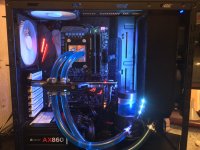Windows Registry Editor Version 5.00
; Vega 56 air - adjusted to match V64 air clocks and power limits.
; % max power increment (50%)
; mV P0-P7 (P0=800mV, 900, 950, 1000, 1050, 1100, 1150, P7=1200mV)
; mV HBM2 (V56: 1250mV) (V64: 1350mV) NB: this setting does not seem to work.
; Hz clock rate (/10) P0-P7 (V56: P0=852, 991, 1138, 1312, 1200, 1474, 1538, P7=1590) (V64: P0=852, 991, 1084, 1138, 1200, 1401, 1536, P7=1630)
; Hz clock rate (/10) HBM2 (V56: 800) (V64: 945)
; W Socket TDP power limit (V56: 165W) (V64: 220W)
; W Battery TDP power limit (V56: 165W) (V64: 220W)
; W Small TDP power limit (V56: 165W) (V64: 220W)
; A TDC current limit (300A)
[HKEY_LOCAL_MACHINE\SYSTEM\CurrentControlSet\Control\Class\{4d36e968-e325-11ce-bfc1-08002be10318}\0000]
"PP_PhmSoftPowerPlayTable"=hex:A7,02,08,01,00,5C,00,EF,06,00,00,0E,2C,00,00,1B,\
00,48,00,00,00,80,A9,03,00,F0,49,02,00,\
32,00,\
08,00,00,00,00,00,00,00,00,00,00,00,00,00,00,02,01,5C,00,40,02,37,02,94,00,\
8F,01,B4,00,1E,01,7A,00,8C,00,AD,01,00,00,00,00,63,02,00,00,90,00,99,02,5E,\
01,34,01,88,01,68,36,02,00,71,02,02,02,00,00,00,00,00,00,08,00,00,00,00,00,\
00,00,05,00,07,00,03,00,05,00,00,00,00,00,00,00,01,08,\
20,03,\
84,03,\
B6,03,\
E8,03,\
1A,04,\
4C,04,\
7E,04,\
B0,04,\
01,01,\
46,05,\
01,01,84,03,00,06,60,EA,00,00,00,40,19,01,00,01,DC,4A,01,00,02,00,77,01,00,03,\
90,91,01,00,05,6C,B0,01,00,07,01,08,\
D0,4C,01,\
00,00,00,80,00,00,00,00,00,00,\
1C,83,01,\
00,01,00,00,00,00,00,00,00,00,\
70,A7,01,\
00,02,00,00,00,00,00,00,00,00,\
88,BC,01,\
00,03,00,00,00,00,00,00,00,00,\
C0,D4,01,\
00,04,00,00,00,00,00,00,00,00,\
44,23,02,\
00,05,00,00,00,00,01,00,00,00,\
00,58,02,\
00,06,00,00,00,00,01,00,00,00,\
B8,7C,02,\
00,07,00,00,00,00,01,00,00,00,\
00,04,60,EA,00,00,00,40,19,01,00,00,DC,4A,01,00,00,90,5F,01,00,00,00,08,28,\
6E,00,00,00,2C,C9,00,00,01,F8,0B,01,00,02,80,38,01,00,03,90,5F,01,00,04,F4,\
91,01,00,05,D0,B0,01,00,06,C0,D4,01,00,07,00,08,6C,39,00,00,00,24,5E,00,00,\
01,FC,85,00,00,02,AC,BC,00,00,03,34,D0,00,00,04,68,6E,01,00,05,08,97,01,00,\
06,EC,A3,01,00,07,00,01,68,3C,01,00,00,01,04,3C,41,00,00,00,00,00,50,C3,00,\
00,00,00,00,70,11,01,00,01,00,00,\
24,71,01,\
00,02,00,00,01,08,00,98,85,00,00,40,B5,00,00,60,\
EA,00,00,50,C3,00,00,01,80,BB,00,00,60,EA,00,00,94,0B,01,00,50,C3,00,00,02,\
78,FF,00,00,40,19,01,00,B4,27,01,00,50,C3,00,00,03,B4,27,01,00,DC,4A,01,00,\
DC,4A,01,00,50,C3,00,00,04,80,38,01,00,90,5F,01,00,DC,4A,01,00,50,C3,00,00,\
05,DC,4A,01,00,00,77,01,00,90,5F,01,00,50,C3,00,00,06,00,77,01,00,00,77,01,\
00,90,5F,01,00,50,C3,00,00,07,00,77,01,00,90,91,01,00,00,77,01,00,50,C3,00,\
00,01,18,00,00,00,00,00,00,00,0B,E4,12,60,09,60,09,4B,00,0A,00,54,03,90,01,\
90,01,90,01,90,01,90,01,90,01,90,01,00,00,00,00,00,02,04,31,07,\
DC,00,\
DC,00,\
DC,00,\
2C,01,\
00,00,59,00,69,00,4A,00,4A,00,5F,00,73,00,73,00,64,00,40,00,90,92,97,60,96,\
00,90,55,00,00,00,00,00,00,00,00,00,00,00,00,00,00,00,00,00,02,02,D4,30,00,\
00,02,10,60,EA,00,00,02,10




